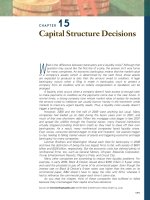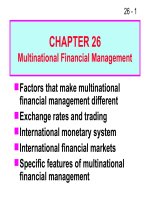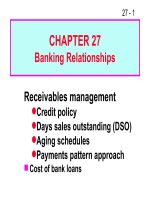FM11 Ch 17 Capital Structure Decisions_Extensions
Bạn đang xem bản rút gọn của tài liệu. Xem và tải ngay bản đầy đủ của tài liệu tại đây (168.3 KB, 55 trang )
17 - 1
CHAPTER 17
Capital Structure Decisions:
Extensions
MM and Miller models
Hamada’s equation
Financial distress and agency costs
Trade-off models
Asymmetric information theory
17 - 2
Who are Modigliani and Miller (MM)?
They published theoretical papers
that changed the way people thought
about financial leverage.
They won Nobel prizes in economics
because of their work.
MM’s papers were published in 1958
and 1963. Miller had a separate
paper in 1977. The papers differed in
their assumptions about taxes.
17 - 3
What assumptions underlie the MM
and Miller models?
Firms can be grouped into
homogeneous classes based on
business risk.
Investors have identical
expectations about firms’ future
earnings.
There are no transactions costs.
(More )
17 - 4
All debt is riskless, and both
individuals and corporations can
borrow unlimited amounts of money
at the risk-free rate.
All cash flows are perpetuities. This
implies perpetual debt is issued,
firms have zero growth, and
expected EBIT is constant over time.
(More )
17 - 5
MM’s first paper (1958) assumed
zero taxes. Later papers added
taxes.
No agency or financial distress
costs.
These assumptions were necessary
for MM to prove their propositions
on the basis of investor arbitrage.
17 - 6
Proposition I:
V
L
= V
U
.
Proposition II:
r
sL
= r
sU
+ (r
sU
- r
d
)(D/S).
MM with Zero Taxes (1958)
17 - 7
Firms U and L are in same risk class.
EBIT
U,L
= $500,000.
Firm U has no debt; r
sU
= 14%.
Firm L has $1,000,000 debt at r
d
= 8%.
The basic MM assumptions hold.
There are no corporate or personal taxes.
Given the following data, find V, S,
r
s
, and WACC for Firms U and L.
17 - 8
1. Find V
U
and V
L
.
V
U
= = = $3,571,429.
V
L
= V
U
= $3,571,429.
EBIT
r
sU
$500,000
0.14
17 - 9
V
L
= D + S = $3,571,429
$3,571,429 = $1,000,000 + S
S = $2,571,429.
2. Find the market value of
Firm L’s debt and equity.
17 - 10
3. Find r
sL
.
r
sL
= r
sU
+ (r
sU
- r
d
)(D/S)
= 14.0% + (14.0% - 8.0%)( )
= 14.0% + 2.33% = 16.33%.
$1,000,000
$2,571,429
17 - 11
4. Proposition I implies WACC = r
sU
.
Verify for L using WACC formula.
WACC = w
d
r
d
+ w
ce
r
s
= (D/V)r
d
+ (S/V)r
s
= ( )(8.0%)
+( )(16.33%)
= 2.24% + 11.76% = 14.00%.
$1,000,000
$3,571,429
$2,571,429
$3,571,429
17 - 12
Graph the MM relationships between
capital costs and leverage as measured
by D/V.
Without taxes
Cost of
Capital (%)
26
20
14
8
0 20 40 60 80 100
Debt/Value
Ratio (%)
r
s
WACC
r
d
17 - 13
The more debt the firm adds to its
capital structure, the riskier the
equity becomes and thus the higher
its cost.
Although r
d
remains constant, r
s
increases with leverage. The
increase in r
s
is exactly sufficient to
keep the WACC constant.
17 - 14
Graph value versus leverage.
Value of Firm, V (%)
4
3
2
1
0 0.5 1.0 1.5 2.0 2.5
Debt (millions of $)
V
L
V
U
Firm value ($3.6 million)
With zero taxes, MM argue that value
is unaffected by leverage.
17 - 15
Find V, S, r
s
, and WACC for Firms U and
L assuming a 40% corporate
tax rate.
With corporate taxes added, the MM
propositions become:
Proposition I:
V
L
= V
U
+ TD.
Proposition II:
r
sL
= r
sU
+ (r
sU
- r
d
)(1 - T)(D/S).
17 - 16
Notes About the New Propositions
1. When corporate taxes are added,
V
L
≠ V
U
. V
L
increases as debt is
added to the capital structure, and
the greater the debt usage, the
higher the value of the firm.
2. r
sL
increases with leverage at a
slower rate when corporate taxes
are considered.
17 - 17
1. Find V
U
and V
L
.
Note: Represents a 40% decline from the no
taxes situation.
V
L
= V
U
+ TD = $2,142,857 + 0.4($1,000,000)
= $2,142,857 + $400,000
= $2,542,857.
V
U
= = = $2,142,857.
EBIT(1 - T)
r
sU
$500,000(0.6)
0.14
17 - 18
V
L
= D + S = $2,542,857
$2,542,857 = $1,000,000 + S
S = $1,542,857.
2. Find market value of Firm
L’s debt and equity.
17 - 19
3. Find r
sL
.
r
sL
= r
sU
+ (r
sU
- r
d
)(1 - T)(D/S)
= 14.0% + (14.0% - 8.0%)(0.6)( )
= 14.0% + 2.33% = 16.33%.
$1,000,000
$1,542,857
17 - 20
4. Find Firm L’s WACC.
WACC
L
= (D/V)r
d
(1 - T) + (S/V)r
s
= ( )(8.0%)(0.6)
+( )(16.33%)
= 1.89% + 9.91% = 11.80%.
When corporate taxes are considered, the
WACC is lower for L than for U.
$1,000,000
$2,542,857
$1,542,857
$2,542,857
17 - 21
Cost of
Capital (%)
26
20
14
8
0 20 40 60 80 100
Debt/Value
Ratio (%)
MM relationship between capital costs
and leverage when corporate taxes are
considered.
r
s
WACC
r
d
(1 - T)
17 - 22
Value of Firm, V (%)
4
3
2
1
0 0.5 1.0 1.5 2.0 2.5
Debt
(Millions of $)
V
L
V
U
MM relationship between value and debt
when corporate taxes are considered.
Under MM with corporate taxes, the firm’s value
increases continuously as more and more debt is used.
TD
17 - 23
Assume investors have the following
tax rates: T
d
= 30% and T
s
= 12%. What
is the gain from leverage according to
the Miller model?
Miller’s Proposition I:
V
L
= V
U
+ [1 - ]D.
T
c
= corporate tax rate.
T
d
= personal tax rate on debt income.
T
s
= personal tax rate on stock income.
(1 - T
c
)(1 - T
s
)
(1 - T
d
)
17 - 24
T
c
= 40%, T
d
= 30%, and T
s
= 12%.
V
L
= V
U
+ [1 - ]D
= V
U
+ (1 - 0.75)D
= V
U
+ 0.25D.
Value rises with debt; each $100 increase
in debt raises L’s value by $25.
(1 - 0.40)(1 - 0.12)
(1 - 0.30)
17 - 25
How does this gain compare to the gain
in the MM model with corporate taxes?
If only corporate taxes, then
V
L
= V
U
+ T
c
D = V
U
+ 0.40D.
Here $100 of debt raises value by
$40. Thus, personal taxes lowers the
gain from leverage, but the net effect
depends on tax rates.
(More )









